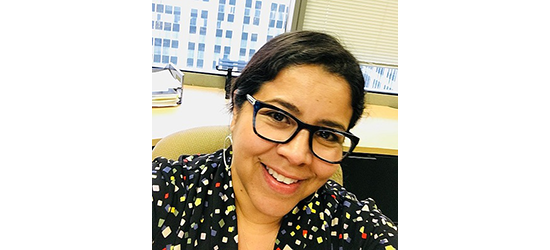In the Spotlight: Aizita Magaña

Aizita Magaña plays a lead role in the region’s fight against COVID-19 this month. As director of planning and public partnerships with the L.A. County Department of Public Health’s Vaccine Preventable Disease Control Program, she shapes communications around one of Southern California’s most critical vaccination efforts of the past century.
Magaña is a public health professional with a passion for reading and research — including vaccine delivery. Interestingly, she is also an independent researcher at The Huntington Library in San Marino, the renowned collection of art, and literary and historical texts. In 2015, her passions converged, and she experienced a media moment when L.A. Times reporter Patt Morrison profiled her work on what we know today as mouth-to-mouth resuscitation — by a doctor who treated President Abraham Lincoln following his shooting by assassin John Wilkes Booth in 1865.

A podcast supplement to the text interview below is available here.
This week’s interview is part of In the Spotlight — a HASC series profiling people connected to the association pursuing innovative, impactful work in their communities.
In your role with L.A. County Dept. of Public Health’s Vaccine Preventable Disease Control Program you’re now intensely focused on delivering the COVID-19 vaccines. Give us an overview of which vaccines are in stock, how many doses, delivery strategy and prioritization.
What vaccines are in stock, the number of doses available and how it gets delivered, is constantly changing. Vaccine eligibility and need currently far outweighs the supply, and a wide range of health care providers and pharmacies are vying for the same available vaccines to meet their demands. Along with issues of supply, making the distribution equitable and accessible to harder-to-reach communities and those disproportionately impacted by COVID-19 is challenging but critical.
There a number of points of distribution (PODs) across the county that provide both walk-up and drive thru vaccination. A growing number of pharmacies, grocery stores, health plans, and clinics also have vaccine available for eligible recipients. The types of vaccination sites will change but also continue to expand.
For the most up-to-date information about the COVID-19 vaccine, including how to make an appointment, call (833) 540-0473 or visit:
Recent news stories give different assessments of Americans’ willingness to receive COVID-19 vaccines. How worried or optimistic are you about the public’s evolving response to the new vaccines?
For the most part, I’m very optimistic. I was so emotional the night the vaccine arrived in Los Angeles. The most important tool we have to stop severe COVID-19 illness, hospitalizations and deaths was finally here and no longer just an abstract hope that I’d kept in the corner of mind all these months!
We’ve only been distributing the vaccine for a short while and I believe the vast majority of people who may have initially declined vaccine, or who are currently taking a “wait and see” attitude, will ultimately choose to be vaccinated. Even during a pandemic, or maybe, especially during one, taking something new can be intimidating. The decision to get vaccinated is complex and made in the context of the influence of family, friends, community and your own personal experience. It’s much more multifaceted than just hearing about clinical trial data or the science of how it protects you. Along with the message, people also have to trust the messenger and that is not always the case. If you’ve had ongoing negative treatment, past and present, from the government, the health care system, public health or pharmaceutical companies, then trust and vaccine confidence are an issue.
The logistics around vaccine distribution are so complex, and so is the communication and messaging that is needed. I strongly believe that to cultivate vaccine confidence, the messenger has to lead with empathy, respect, and patience. You won’t change people’s minds about the vaccine with fear or threats or perhaps not even with more information. I trust that people are trying to make the best decisions they can about their own health and the health of their families. We need to listen to and acknowledge people’s concerns. If someone is concerned about vaccine side effects that is one thing, but if they are questioning the intentions of those who are supplying and administering the vaccine, then efforts must be made to earn trust and build the relationships that help make vaccine acceptance possible.
A good basic understanding of the vaccine’s safety and benefits is important, however it will less often be information alone that changes someone’s mind, and more often a human and interpersonal exchange with someone, or acknowledgement and reassurance from a group of people, that they connect with and trust. The public’s response to the vaccine I’m sure will be somewhat of a rollercoaster, based on many external events, including supply and access. But ultimately people will want to get vaccinated because it not only protects themselves, but also their families, friends and community. I hear a lot about people who are remaining cautious and waiting to be vaccinated after they can see what the experience of many others turns out to be. The more people they see — family, friends, co-workers, community members, others that they know or trust being vaccinated, and without any significant side effects, the more their own confidence will grow and along with it, the willingness to be vaccinated themselves.
A recent collaboration brought hospitals, HASC, L.A. County public health and others together to communicate flu vaccines’ safety and effectiveness to the public. What lessons learned stand out as public health organizations pivot to the novel coronavirus vaccination drive — especially in underserved communities?
Collaboration and partnership are everything. As individual agencies and organizations, we possess a great deal of expertise and resources that can be leveraged, but the need to work together right now goes way beyond being more efficient or coming up with better practices.
Vaccine distribution is an all hands-on deck situation. The communities we serve, in this moment, are depending on us to work together to make sure they get access to vaccine, know if they are eligible, get navigation support for an appointment, come to understand its safety, its benefits, how it works to protect you, and how important it is for us to take it.
At the Huntington Library you discovered a fascinating account of President Lincoln’s assassination, and how Dr. Charles Leale’s use of mouth-to-mouth resuscitation extended the president’s life by close to nine hours and which ultimately led to widespread endorsement of the technique by the medical profession. Tell us a bit more about your interest in respiration and your work at the library.
When I was in my early twenties I got caught in a rip tide swimming at Dana Point in Orange County. Drowning happens much more quickly and quietly than people commonly believe. Once you swallow water, or worse, panic like I did, your every effort will be on trying to catch your breath, making yelling for help almost impossible. You also need some semblance of control to be able to wave for help. It’s just not possible to keep your head above water if you are holding your arms up straight in the air. I was swimming that day with a friend who thankfully managed to get me to focus long enough to swim parallel to the shore and safely out of the rip current. I was left sort of traumatized by the experience but it also set me off on an obsessive journey to understand in the most practical terms, the physiology of breathing (and drowning). I ended up going to a conference just about drowning to know more and meet other people who’ve had a near-drowning experience. I enjoy writing about and sharing in lay terms, what I’ve learned about the medical and scientific history of the breath, and in a much broader and cultural context, how, and why we breathe. It’s stories about people as much as it is the science. Lincoln’s case intrigued me because there was a lot of ambiguity on how Leale knew how to use, or if he actually did use, mouth-to-mouth resuscitation techniques. Breathing appears to be the most basic bodily function but it’s extraordinary and complex.
I was really fortunate to access the history of medicine and science collection at The Huntington Library — it was for me, very much a room of one’s own experience, not to mention the beautiful gardens surrounding you right outside. I struggled at first to shake the so-called imposter syndrome, being a woman of color and an independent scholar, but the library staff were very welcoming and supportive.
You attended UC Berkeley and earned an MPH at the University of Michigan. Where did you grow up and attend high school? Tell us briefly about your family.
Yes, I was very lucky to attend these great public universities. They are both located in wonderful cities, with diverse campuses and I had the support of some remarkable professors. I grew up in the Inland Empire, in the city of Yucaipa, and then attended high school in Claremont. Both are lovely places but the air quality back then was a series of first stage smog alerts. There are some beautiful mountains nearby, but back then there were many days that you just couldn’t see them!
I am the very proud granddaughter of grandparents who immigrated from Michoacán, Mexico. I benefited greatly from my grandparents’ and my parents’ struggle, hard work and sacrifice. Beyond being hard-working, they had a lot of vision and intelligence, but not always the acceptance of the broader culture. They encountered a lot of racism and discrimination that added to their struggle. It’s a legacy that contributed to my professional commitment to make health services more equitable, inclusive and respectful of people’s culture, language and experience.
What should health care professionals — or anyone for that matter — keep in mind as we push through this critical phase of the pandemic?
As more of us have the opportunity to be vaccinated, I hope we don’t ever forget the devastating and disproportionate impact COVID-19 has had on so many people including health care workers, essential workers, older adults, and communities of color. When we have the chance via the miracle of this vaccine, to regain more normalcy, we must continue to collaborate to remedy and correct the racial, health and economic inequities that existed before the pandemic.
The pandemic exacerbated health care disparities and clearly revealed inequities that were made profoundly worse by COVID-19. More than simply recover, we must strive to serve, strengthen and support vulnerable populations, improve systems of health care, public health and community-based services and make ongoing efforts to address social determinants of health.
Contact HASC Publications Director Erik Skindrud with comments or ideas for future In the Spotlight interviews.
Contact:
Erik Skindrud
(213) 538-0728
eskindrud@hasc.org



